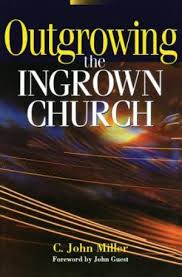BOOK REVIEW: Outgrowing the Ingrown Church by C. John Miller (1986, Zondervan) Part  2
2
(this post is the second part of my review, to see the first go here)
Miller goes on explain how God’s glory is the missionary motive for the church (ch 5). He gives four steps to pursue a renewal of the church’s understanding of this motive:
1. Develop an openness to Gods vision for the local church
2. Work to develop an honesty about your sins and weaknesses
3. Personalize your relationship with Christ
4. Commit yourself to express God’s glory in every part of your life
(“publicize or express the wonder of His person and works” (77)
An ingrown church also needs to repent of its coldness toward outsiders. It must be hospitable: “aggressively and joyfully seek[ing] out the unchurched, laboring to welcome them into the church as members of the body of Christ.” Along with this, “Its leaders self-consciously [must] reject a “Christian clubhouse” atmosphere and devote themselves to developing in the congregation an open face to the community and the world beyond” (81). Miller states sadly, “it is often easier to inspire Christian people to go overseas as “missionaries” than it is to get them to welcome their neighbors into their lives” (81).
Another sign of a healthy church is a praying church with strong preaching. Such praying is not just for Aunty Betty’s hip surgery, but for the lost to be saved (ch 7). The church must labor in strategic outward looking prayer. The preaching needs to be gospel-centered. Miller presents the Reformed understanding of Law and Gospel in preaching: “the law awakens us to the fear of God and establishes real needs. But only the gospel can transform and renew lives damaged… the law demands perfect love from us, but only the gospel provides Christ, the Great Substitute, who in love kept the law perfectly and paid its penalty on the cross” (132). He notes the sad reality, that the gospel is often “trivialized by being separated from God’s law and majesty, or it is not being applied concretely to the needs, fears, and values of the congregation. Here, the pastor’s role as a trainer enters in. The pastor must teach his people to face specific sins and fears, and to apply the spiritual power of the gospel to put them to death, and to use the resulting freedom to exercise gifts in service to Christ” (144).
Along with preaching, the pastor must equip his congregation for gospel ministry. This is made up of two tasks: teaching the gospel and training others in service. Miller believers that the congregation must see that “the gospel of grace is…the basis on which all exhortations to duty and pacesetting obedience rest” (142); the gospel provides “the basic power, inspiration and motivation in discipline” (143). To equip a congregation, Miller argues for the following discipleship program:
1. Help the congregation understand justification by faith and our adoption in Christ
2. Use this assurance of God’s love to develop: regular early morning devotions, tongue control, journal keeping, discipling, witnessing, and gift identification, and working on a team.
Overall, I’m very impressed with Miller’s book and would thoroughly recommend it to all in the church and pastoral ministry. God help us repent of selfish, cowardly, ingrown tendencies and help us press forward to preach the gospel to all, forsaking our own comforts and reputation.
